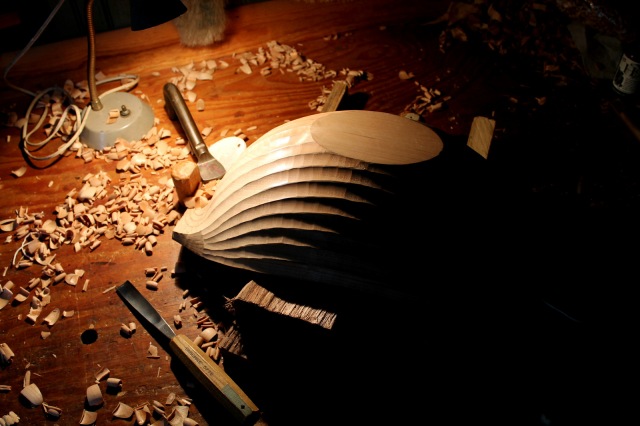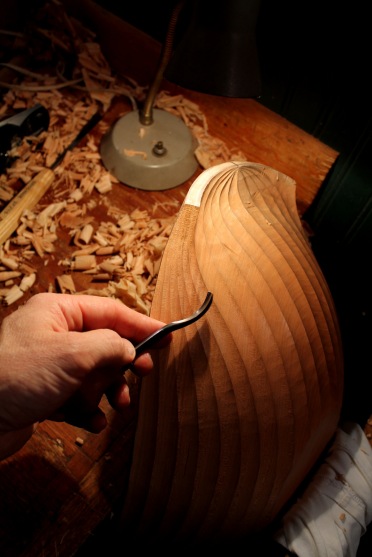
I really admire people that can play musical instruments, all the more since I’ve tried to do so myself — with poor results. For the past couple months, I’ve been playing around with a penny whistle, and you should hear my “Twinkle Twinkle Little Star.” My neighbors are forced to, after all.
I’ve had much more practice playing with flutes of the carved variety. A pretty straightforward idea: a series of hollows separated by raised ridges. That simple idea allows for a lot of creative possibilities. The hollows can taper and curve in various ways, and I like how they can accentuate the lines and form of a piece. Various gouge sweeps and how they are wielded also provide design opportunities. This slideshow features a few examples of how I’ve used flutes on some bowls:
Regardless, the process is the same: make sure the surface is fair and true, draw nice ridge lines, hollow between them with control. That’s it.
I’ve tried ways to define the layout of the flutes, but I’ve found that the best way comes down to simply hand drawing by eye — and erasing, lots of erasing. A pair of dividers comes in handy for evenly dividing spaces at a spot or two, but I find the lines are poor if this is relied upon much. After all, we are dealing with sculpted surfaces that are not uniform or perfectly symmetrical. Mark a few guide points, then trust your eye.

Move the bowl around as you draw the lines, holding it in a way that allows for a natural motion of the drawing hand.
Once I’m happy with the drawn lines, I carve the flutes in two stages. On my first pass, I remove most of the material in the hollow with the gouge, but leave an eighth inch or so around the pencil line. I do this over the entire piece before moving on to the second pass.

After the first pass with the gouge. Notice the flats left between the flutes at this stage.

Another shot showing the bulk removal of the first pass, as well as the holding set-up which varies, depending on the bowl. In this case, an effective mix of pegs, holdfasts, wedges, and “hunks of wood”. I turn off any overhead lights and use the desk lamp to throw shadows where I need them to see things clearly.
The second pass deepens and widens each flute so that the pencil line is just removed leaving a distinct defining ridge line between adjacent hollows. If you push the line over too far, it can be brought back by working the neighboring hollow, but try to minimize that or the ridge line may end up looking true when viewed from above but be a bit of a wavy mess when viewed from the side. Take your time and enjoy the slow process.

In this photo, I’ve been working from right to left bringing the ridges between the hollows to distinct lines. Notice the difference with the flutes to the left and to the right.
On this latest cherry bowl, I carved a pattern of flutes different from any I had done before. Several of the flutes taper and converge at the ends of the handles, while the lower flutes flow and curve under the handles. Among the challenges of executing the design is cutting the flutes under the handles, a good job for a spoon-bent gouge.

Still working with a spoon-bent gouge to shape the flutes winding under the handles.
Here’s a slideshow of some more photos of this bowl, which has already hit the road. My first Alexander chair provides some sense of scale, but the bowl is 18 1/2 inches long, 11 inches wide, and 6 1/2 inches high. Now I’ve got to get back to my other flute; “London Bridge” is next in the book. The neighbors are sure to like it more than “Twinkle Twinkle.”

Stunning work…but, I don’t hear any music accompanying the slide show.
LikeLike
I could have played the background music! Good idea, but be glad I didn’t think of it.
LikeLiked by 1 person
Hi Dave
I notice the 5/18 in the picture and the spoon looks smaller and deeper. In those flutes how many different widths and sweeps did you use?
Thanks Bill
LikeLike
Hi Bill. On most bowls, I just use one gouge for all of the fluting. On this one I had to switch to a couple others under the handles as the shape became concave and tighter. As you saw, the 5/18 straight gouge was used for the convex portions, then a similar sweep bent gouge, then finally that bent gouge. It is a steeper sweep and narrower, since the flutes converge. Specific sizes and numbers aren’t critical, but I think it was a 8/10 or so.
LikeLike
Dave , Thanks for the lesson,as usual I take a deep breath when I see a new post with a beauty such as this one.Your attitude, instruction and jokes are just as great.Thanks for sharing with us all your knowledge.There is a saying about a man that plants a tree knowing that he will never stand in it’s shade.I hope you realize you are that kind of person.
LikeLike
Elegant design. Exquisite craftsmanship. A sense of humor. And generous sharing of information. David, you are not only a true artist, you are an admirable person. Thank you for all you show us and all you share with us.
Ron
LikeLiked by 1 person
Beautiful bowl. Love the “weeping tree”, etc. on the base too and the interior texture – just sublime.
Thank you for the article. I’d recently starting thinking about carving flutes on bowl, inspired by you previous posts, so the timing is perfect. 🙂 It reads like a masterclass – a very good, concise one at that. Lots of tips and insights which will no doubt help avoid several potential pitfalls – thank you.
Interesting to see the use of the bent spoon gouge too – I was lucky enough to find a nice old one a year or two ago on ebay for a reasonable price. More recently, I bought a couple of very nicely restored, large, broad, fish tail gouges (with new boxwood London-pattern handles) – not exactly what I was looking for but it struck me that this was a once-in-a-lifetime opportunity and they should work well. The ebay prices of vintage tools in the UK have risen considerably over the last 6 years (one seller told me he sells a lot of his old gouges & chisels to Russia). Fortunately, I am now well equipped & should probably sell off one or two tools – but you never know when you might need them! 😀
LikeLiked by 1 person
Great post Dave. Love the “get going” attitude. Not that the carving is “simple” I am sure, but I like the “that’s it” encouragement. And the photos. Really nice light.
LikeLiked by 1 person
Pingback: A fortuitous mistake – Treen Works, literally from a tree
Pingback: Maple Hen | David Fisher, Carving Explorations
Dave, you have got to get yourself a ukulele……… and some of the best ones are built very near to you.
LikeLike
I try a ukulele once in awhile, Phil, but I need a lot of work! What place near me were you thinking of?
LikeLike